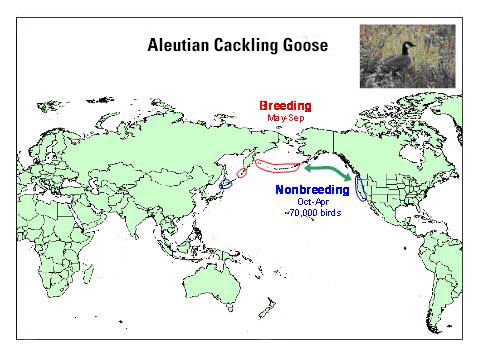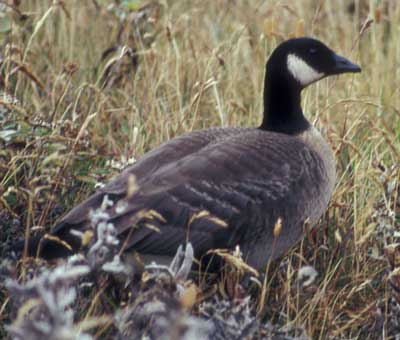Aleutian Cackling Geese, Branta hutchinsii leucopareia
High-Priority Species ListA portion of the population of Aleutian Cackling Geese breeding on the Aleutian Islands may winter in Japan where they could possibly contract Asian H5N1, and the majority of geese breeding in the western Aleutians occupy islands visited by hundred of direct Asiatic migrant birds of a number of species directly from Asia annually.
Aleutian Cackling Geese breed on the western end of the Aleutian Islands (Byrd 1998). An eastern Asia taxon, formerly identified as a separate subspecies, B. c. asiatica, reportedly bred in the Komandorski and Kuril islands and wintered in Japan, but the population was wiped out by the 1940’s (Mowbray et al. 2002). Based on only a few specimens, asiatica is now considered identical, by several authorities synonymous, with B. h. leucopareia. Since the middle of the 20th century, only vagrant individuals of B. h. leucopareia and B. h. minima from North America have occurred in Korea and Japan. However breeding stock of B. h. leucopareia that originated from Buldir Island, have been reintroduced to the Kuril Islands and have been recorded wintering in Japan (N. Gerasimov, unpubl. data). The Aleutian Cackling Goose is of low rank of waterfowl species to make the final list of 26 species of concern for Asian H5N1 transmission in the National Plan, primarily because we have a poor understanding of movements between Alaska and Asia. Nevertheless, the likelihood of secondary contact with Asian H5N1 is high, given the plethora of Asian birds using the western Aleutians (25 species are annual through migrants, and more than 90 species occur less than annually). Like nearly every other species of waterfowl considered, the main threat of contacting the Asian H5N1 virus is from other species, or populations of the same species coming directly from Asia and carrying the virus to the continental U.S. Aleutian Cackling geese winter in California.
No. of samples: Total of 400 samples, including 200 fecal samples from nesting birds and 200 cloacal swabs from brood flocks.
Sampling locations: Samples will be collected at different Islands in the Aleutian chain, including Buldir, Shemya and Agattu where Alaska Maritime NWR will have crews in place for seabird monitoring.
Sampling timeframe: Primary time frames will be late May to early June when birds are on nests, and late July and early August when adults with young are flightless.
Sample demographics: Geese of all age and sex classes will be sampled. Fecal samples of nesting birds will only include adults.
Methods of capture: Samples of nesting birds will likely be restricted to fecal specimens obtained in areas where nesting birds have recently foraged. Flightless birds will be captured be a field crew on Buldir Island by using long-handled nets.
Other targeted species: Sampling during the nesting period on Agattu will be done in conjunction with sampling for Common Eiders. Asiatic species are abundant on the Aleutian Islands and it may be possible to obtain fecal samples from a number of them.
Sampling locations: Samples will be collected at different Islands in the Aleutian chain, including Buldir, Shemya and Agattu where Alaska Maritime NWR will have crews in place for seabird monitoring.
Sampling timeframe: Primary time frames will be late May to early June when birds are on nests, and late July and early August when adults with young are flightless.
Sample demographics: Geese of all age and sex classes will be sampled. Fecal samples of nesting birds will only include adults.
Methods of capture: Samples of nesting birds will likely be restricted to fecal specimens obtained in areas where nesting birds have recently foraged. Flightless birds will be captured be a field crew on Buldir Island by using long-handled nets.
Other targeted species: Sampling during the nesting period on Agattu will be done in conjunction with sampling for Common Eiders. Asiatic species are abundant on the Aleutian Islands and it may be possible to obtain fecal samples from a number of them.
U.S. Fish and Wildlife Service
U.S. Geological Survey
Alaska Maritime NWR
Contact: Vernon Byrd
Contact: Vernon Byrd
U.S. Geological Survey
Alaska Science Center
Contact: Margaret Petersen
Contact: Margaret Petersen
Byrd, G. V. 1998. Current breeding status of the Aleutian Canada Goose, a recovering endangered species. Pp. 21-28 In Biology and management of Canada Geese (D.H. Rusch, M.D. Samuel, D. D. Humburg, and B. D. Sullivan, eds.).
Mowbray, T. B., C. R. Ely, J. S. Sedinger, and R. E. Trost. 2002. Canada Goose (Branta canadensis). In The Birds of North America, No. 682 (A. Poole and F. Gill, eds.). The Birds of North America, Inc., Philadelphia, PA.

Ranking Score: 11.0
Asian H5N1 ranking criteria for Aleutian Cackling Geese, Branta hutchinsii leucopareia.
Total of partial contact with Asia1 |
Contact with known "hot spot"2 |
Habitat used in Asia3 |
Pop. in Alaska4 |
Can samples be obtained? |
Score |
1.0 |
1.0 |
4.0 |
3.0 |
2.0 |
11.0 |
Small numbers breed on Commander Islands and winter in Asia |
No known use of AI-infected areas |
Breeds on Aleutian Islands in wet, grassy freshwater meadows |
Approximately 70,000 birds in fall population |
Could be difficult to obtain target number in Alaska |

